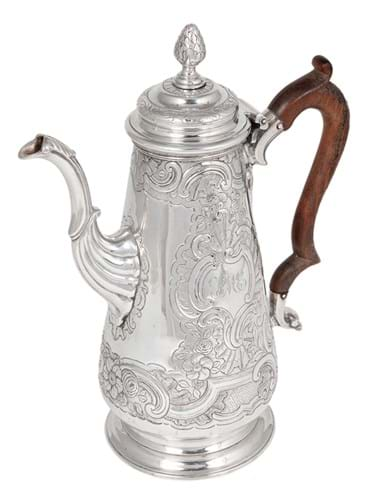It came in the form of this 11½in (29cm) George II period silver coffee pot c.1775 marked for Anthony Danvers to both lid and base and struck with the Jamaican sterling standard mark of an alligator's head. It was possibly made by Abraham Le François, who moved to Jamaica from England in 1749, around the same time as Danvers. The initials SME engraved to the body were added later.
Ornately chased with the contemporary style of rococo scrolls and foliage, the vessel reflects the island's great wealth based on sugar cane plantations, the slaves imported from West Africa who worked them, and rum production.
Jamaica supported at least 23 goldsmiths in 1775, around the time when this coffee pot was made. From 1747 until about 1765, an assay master regulated the quality of gold and silver wares made on the island - unusual for British Colonies at the time. The act of 1747 stipulated that an assay master be appointed, who would be "obliged to mark the said gold and silver wares with the stamp or mark of an alligator's head, and the initial letters of his own name", as seen on this example.
Although Jamaican silver is a rare visitor to the saleroom, a few other pieces marked for Danvers have appeared on the market over the past decade or so: at Bonhams a pair of silver candlesticks sold for £8000 in 2003 and at Christie's South Kensington a small silver snuffers tray c.1760, took £1700 in 2009.
Matthew Barton's example, an inherited piece consigned from a private source, carried an estimate of £3000-5000 but on the day doubled this to take £10,000 from a UK private buyer. The buyer's premium was 20%.






